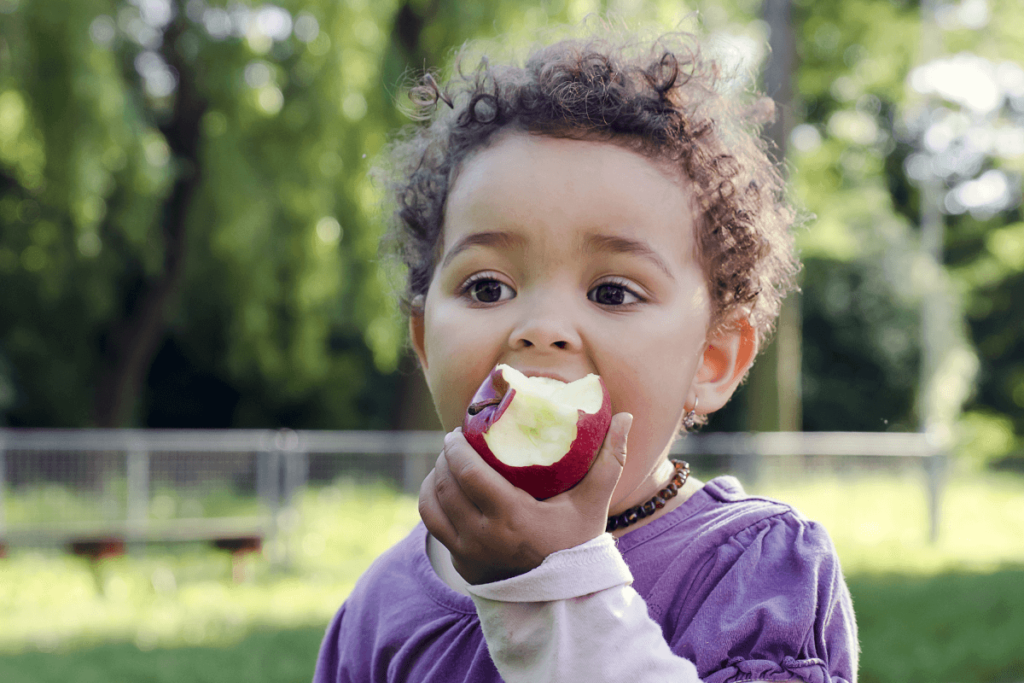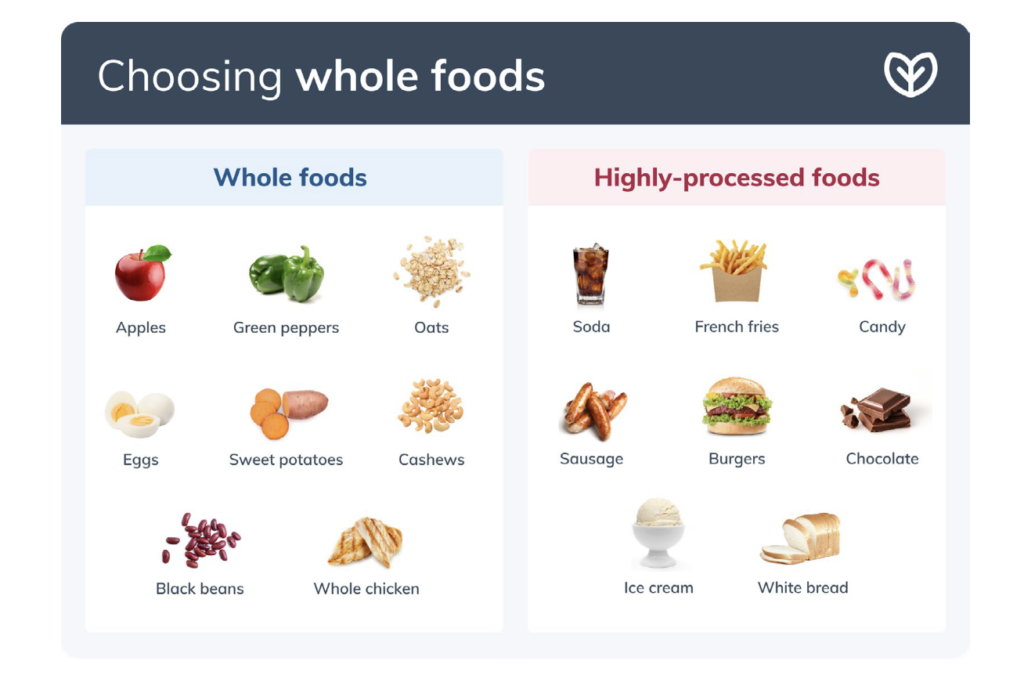Parents and caregivers play a significant role in childhood development. A healthy diet is an important part of helping children grow and learn. (14) This is often easier said than done, as approximately 25 to 35% of toddlers and preschoolers are described by their parents as poor or picky eaters. (6) Getting children to eat healthy food is essential for meeting nutrient needs and improving their long-term health and well-being. (2)
Fortunately, even picky eaters can learn to adopt a healthy diet with repeated exposure and positive reinforcement. Keep reading below to learn more about establishing healthy eating habits for children.
Dietary guidelines for children
The dietary guidelines for children are similar to those for adults but with appropriate portion and calorie modifications. Children two to 18 years old should regularly eat fruit, vegetables, whole grains, lean protein foods, seafood, and low-fat dairy products. These nutrient-dense foods provide necessary vitamins and minerals and other health-promoting nutrients such as antioxidants. There are also unhealthy foods that children should limit, including those containing added sugars, excess sodium (salt), or high saturated fats. (2)
To learn more about appropriate foods, caloric goals, and portion sizes for children and adolescents, review the Dietary Guidelines for Americans or Canada’s Dietary Guidelines.
6 tips for developing good nutritional habits in children
Food preferences are developed early in life, with most infants being introduced to complementary foods (foods in addition to breast milk or formula) around six months old. (2) Exposing infants to a variety of healthy foods can help support good eating habits in the future. (1) Once these little ones grow to toddler and preschool age, it brings many developmental changes, including nutritional habits. Throughout this age range (two to five years old), communication, exposure, and social influences become key components of establishing long-term healthy habits. (6)(12)
From household to childcare settings, the following tips may be beneficial for getting children to eat healthier.
1. Be a role model
Parent lifestyle habits, including food and beverage choices, greatly influence the habits their children will develop. (12) Adhering to a healthy lifestyle will make limiting unhealthy habits in your children easier. Nutritious foods and regular exercise are key for maintaining overall health and preventing chronic diseases (e.g., obesity, type 2 diabetes) in children and adults. Try to eat the same foods as your children and engage children in healthy lifestyle activities you can do together, such as going to the park instead of watching tv. (13)

2. Offer healthy food choices
A healthy diet doesn’t have to be complicated or expensive. Cooking at home is generally cheaper than regularly eating out, such as at fast-food restaurants. (11)(18) It also gives you more control over what cooking methods and ingredients are used. When serving healthy meals at home, try to:
- Avoid sugary juices and sodas and stick to drinking water.
- Bake, grill, or steam foods rather than fry them.
- Choose lean meats (e.g., chicken breast), seafood, eggs, and legumes as protein foods more often than sources high in saturated fat (e.g., bacon, roast beef).
- Fill half the plate with fruits and vegetables.
- Choose whole grains, such as whole-grain bread and cereals, more often than refined grains. (2)(14)
When stocking your refrigerator and pantry, keep junk food (e.g., candy, fried foods) to a minimum and choose whole foods (e.g., fresh fruits and vegetables) whenever possible. Children’s appetites may change frequently, so keeping healthy snacks on hand is recommended. (6) Try designating a shelf or drawer for kid-friendly healthy snacks, such as carrots, low-fat string cheese, and oranges. These light snacks will help your child feel satisfied but still hungry when it’s time for their next nutrient-dense meal. (2)

3. Practice mindful eating
Mindful eating is the concept of being present and acknowledging your emotions and physical sensations without judgment. (4)(17) When you eat mindfully, you eat slowly, bringing your full attention to your food. (5)(15) Eating at the table together and removing distractions (e.g., toys, television) is a great way to start eating more mindfully. Mindful eating is also an opportunity to bond with your child and bring attention to the food’s colors, tastes, and textures. (9)
Mindful eating also has many health benefits, starting with helping children and adults become more familiar with their hunger and fullness cues. This may help address or prevent weight gain, disordered eating patterns, and chronic diseases like type 2 diabetes. (3)(10)(20) Regularly eating meals as a family is also positively associated with increased healthy food consumption. (16)
4. Get the kids involved
Whether it’s grocery shopping or food preparation, involving children in the process will help support healthy eating habits. When grocery shopping, consider letting your child choose a new fruit and vegetable to eat that week. If they’re old enough, children may help prepare meals, such as mixing, washing or drying fruits and vegetables, measuring, or scooping. Empowering children and helping them develop new skills may encourage children to be curious about new foods. (19)

5. Use positive language
Verbal and nonverbal communication make a big difference in a child’s nutritional habits and preferences. Excessive control or pressure regarding your child’s eating patterns may negatively impact their relationship with food. Avoid using food as a reward or pressuring children to eat everything on their plates. These practices can teach children to ignore fullness cues or lead them to use food as a reward in the future. (12)
6. Keep trying
Around two years old, children may develop neophobia, a reluctance to eat or try new foods. These picky eaters may no longer like even some of their favorite foods, which can make daily life difficult. (7)(12) Some children need around 15 exposures to a new food before they’re willing to taste it. Throughout this period, it’s important to continue using positive language and role modeling to encourage your child. (12) Contact your family medicine practitioner to learn more about neophobia and preventing nutritional deficiencies in children who are picky eaters.
The bottom line
Young children are at an impressionable age for developing food preferences and habits. Without proper nutrition, children are at risk for nutrient deficiencies or developing chronic health conditions, such as iron deficiency anemia and obesity. Leading by example, using positive language, and exposing children to unfamiliar foods are a few ways to encourage long-term healthy eating habits. To learn more about nutrient requirements for children or how to address neophobia, consult with your healthcare provider.
- Anzman-Frasca, S., Ventura, A. K., Ehrenberg, S., & Myers, K. P. (2018). Promoting healthy food preferences from the start: A narrative review of food preference learning from the prenatal period through early childhood. Obesity Reviews: An Official Journal of the International Association for the Study of Obesity, 19(4), 576–604.
- Dietary guidelines for Americans (2020-2025). (2020). https://www.dietaryguidelines.gov/
- Janssen, L. K., Duif, I., van Loon, I., de Vries, J. H. M., Speckens, A. E. M., Cools, R., & Aarts, E. (2018). Greater mindful eating practice is associated with better reversal learning. Scientific Reports, 8(1), 5702.
- Keng, S.-L., Smoski, M. J., & Robins, C. J. (2011). Effects of mindfulness on psychological health: A review of empirical studies. Clinical Psychology Review, 31(6), 1041–1056.
- Kristeller, J. L., & Jordan, K. D. (2018). Mindful eating: Connecting with the wise self, the spiritual self. Frontiers in Psychology, 9, 1271.
- Leung, A. K., Marchand, V., Sauve, R. S., & Canadian Paediatric Society, Nutrition and Gastroenterology Committee. (2012). The “picky eater”: The toddler or preschooler who does not eat. Paediatrics & Child Health, 17(8), 455–460.
- Łoboś, P., & Januszewicz, A. (2019). Food neophobia in children. Pediatric Endocrinology, Diabetes, and Metabolism, 25(3), 150–154.
- Merriam-Webster. (n.d.). Definition of “whole food.” https://www.merriam-webster.com/dictionary/whole%20food
- Miller, C. K. (2017). Mindful eating with diabetes. Diabetes Spectrum: A Publication of the American Diabetes Association, 30(2), 89–94.
- Miller, C. K., Kristeller, J. L., Headings, A., & Nagaraja, H. (2014). Comparison of a mindful eating intervention to a diabetes self-management intervention among adults with type 2 diabetes: A randomized controlled trial. Health Education & Behavior: The Official Publication of the Society for Public Health Education, 41(2), 145–154.
- Mills, S., Brown, H., Wrieden, W., White, M., & Adams, J. (2017). Frequency of eating home cooked meals and potential benefits for diet and health: Cross-sectional analysis of a population-based cohort study. The International Journal of Behavioral Nutrition and Physical Activity, 14(1), 109.
- Mitchell, G. L., Farrow, C., Haycraft, E., & Meyer, C. (2013). Parental influences on children’s eating behaviour and characteristics of successful parent-focussed interventions. Appetite, 60(1), 85–94.
- National Institute of Diabetes and Digestive and Kidney Diseases. (2019). Helping your child: Tips for parents and other caregivers. https://www.niddk.nih.gov/health-information/weight-management/healthy-eating-physical-activity-for-life/helping-your-child-tips-for-parents
- National Institutes of Health. (2019). Child nutrition. MedlinePlus; National Library of Medicine. https://medlineplus.gov/childnutrition.html
- Nelson, J. B. (2017). Mindful eating: The art of presence while you eat. Diabetes Spectrum: A Publication of the American Diabetes Association, 30(3), 171–174.
- Scaglioni, S., De Cosmi, V., Ciappolino, V., Parazzini, F., Brambilla, P., & Agostoni, C. (2018). Factors influencing children’s eating behaviours. Nutrients, 10(6).
- Sharf, R. H. (2015). Is mindfulness Buddhist? (and why it matters). Transcultural Psychiatry, 52(4), 470–484.
- Tiwari, A., Aggarwal, A., Tang, W., & Drewnowski, A. (2017). Cooking at home: A strategy to comply with U.S. dietary guidelines at no extra cost. American Journal of Preventive Medicine, 52(5), 616–624.
- U.S. Department of Agriculture. (2022). Healthy eating for kids. https://www.myplate.gov/tip-sheet/healthy-eating-kids
- Warren, J. M., Smith, N., & Ashwell, M. (2017). A structured literature review on the role of mindfulness, mindful eating and intuitive eating in changing eating behaviours: Effectiveness and associated potential mechanisms. Nutrition Research Reviews, 30(2), 272–283.





